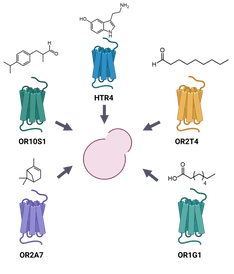

Chemical Biosensing
Biological systems use G protein-coupled receptors (GPCRs), tyrosine receptor kinases, gated ion channels, and nuclear receptors to detect chemicals in their environment. GPCRs are particularly interesting as they bind the most diverse array of chemicals, from neurotransmitters and hormones, to odorants and flavors. Of the ~ 800 GPCRs, 360 are non-sensory with ~130 of them targeted by FDA approved drugs. The remainder are called sensory GPCRs, and are involved in olfaction (400), taste (33) and light detection (10). Over the last eight years, we have used our yeast-based GPCR-based sensor system to detect advanced biofuel precursors (Mukherjee et al. 2015), microbially produced chemicals (Ehrenworth et al. 2017; Sarria et al. 2018), odorants (Yasi et al. 2019; Patel & Perlta-Yahya, 2022) and for drug discovery applications (Yasi et al. 2019, Marquez-Gomez et al. 2022).

Today, we are using computational approaches to decipher the chemicals olfactory receptors bind outside the olfactory tissue. Using protein engineering approaches, we are designing GPCRs with specific features to develop medically relevant biological circuits.
Chemical Bioproduction
(Kruyer et al. 2021) .We are interested in leveraging biological systems to produce chemicals from renewables. In particular, our focus is on chemicals that biological systems have a comparative advantage in producing at large scale due to their chemical structure or constrains imposed on the production process. Over the last eight years, we have developed platforms for the production of the jet fuel precursor pinene (Sarria et al. 2014), advanced biodiesel precursors, medium-chain fatty acids (Sarria et al.2018), the pharmaceutical tetrahydrobiopterin (Ehrenworth et al. 2015; Kiattisewee et al. 2021) and the pharmaceutical intermediate hydroxystrictosidine (Ehrenworth et al.2015), and the commodity chemical adipic acid (Kruyer et al. 2020). We have also propose the bioproduction of advanced biofuels on Mars (Kruyer et al. 2021), and the use of synthetic cells for chemical bioproduction (Kruyer et al. 2021).
Today, our focus is on bio-upgraging CO2 to value-added chemicals and designing microes with more efficient carbon conversion metabolims (press releases here and here). Those projects include modelling, protein engieering and metabolic engineering approaches.
